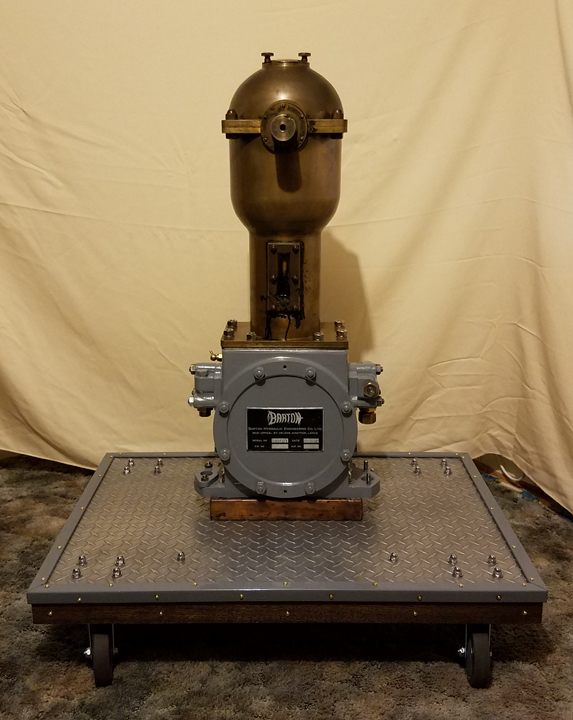Tommy Thompson aboard the Arctic Discoverer, 1980s
The ships wheel and mount are an important part of the museum display. After over two years, I am finally on track to getting the project finished. Parts restored and mounted for display, 4-30-2016
|
|
The Barton gear box still attached to the bridge just before I removed it. This thing weighs approximately 155 pounds. I had to wheel it down two flights of stairs to the main deck to get it off the ship. About halfway down the stairs. I lost control of the hand truck and had to let go of it to keep from being dragged down the steps with it. The box, strapped to the hand truck, took out a section of wall and rail before coming to a rest at the bottom. No damage to the gearbox however.
|
|
In order to reassemble the wheel mount, I needed a base that would hold the weight of the gearbox, wheel stand and the wheel, altogether over 250 pounds. I built this stand out of 2" x 6" and 8" boards with a 3/4" oak top. I added 350 lb. coasters to move the display around easily. Plus 2, 1/4" aluminum angle braces to help with the weight.
|
|
The base with the first piece of the original mount installed. This wood block is what the Barton mount was attached to on the ship. I cleaned it and added a coat of stain. Notice the notch cut in the front/center of the wood block. This is to allow the bleeder valve on the bottom of the Barton mount to sit. Excess oil would drain from this valve. It apparently drained into this wood block for the past 58 years. Every time the block gets warmed up, it begins to "bleed" oil from all sides. Once it cools off, the oil recedes back into the wood? The blood of the ship in the wood mount!
|
|
The Barton gear box installed on the wood block, with a fresh coat of paint.
|
|
The brass wheel stand installed, waiting for the wheel. The original wheel was removed from the ship before I arrived. I found as many pictures as I could of the wheel and looked through the ships inventory from 1958 to find out the exact dimensions and type of wheel used. I located one in the United Kingdom in the collection of a Royal Naval Officer. It is a circa 1950s, 42" wheel with the same hub, spokes etc. as the original. I was able to purchase the wheel and have it shipped here to be mounted on this display.
|
|
 |
Well, I thought I was done. The museum curator did not like the red mount, he decided he wanted it painted blue. So I painted it blue. Then he decided he didn't like the blue, he wanted it to be a natural wood mount. So I took it apart again and reworked it with oak, birch wood and stain. Then he decided he liked the blue better! So I painted it blue again. Then he thought it would look good with a blue stain to show the wood grain... Once that was done he didn't know what to do with it as he didn't like any of the previous colors and stains? Sandy looked at it and said "Why not just have diamond plate metal?" So I went to the scrap yard and bought a piece of diamond plate aluminum. Then the curator said, "It looks too shiny, can you make it look old like the rest of the ship parts?" I took a wire wheel and brushed off the shine. Then I took a medium grade scotch brite pad and buffed it, then a lighter grade pad and used 'Mothers Aluminum polish' and polished it to a semi gloss look. I think it looks old. Everyone agreed, and now it is finally finished! 6-18-2016. Remember, the customer (the guy running the museum) is always right, even if they are nuts!
|
|
 |
 |
Finito! The finished product with original Arctic Discoverer wood base, Barton gear box and brass wheel stand. Mounted on the new diamond plate aluminum base with oak trim.
|
|
 |
